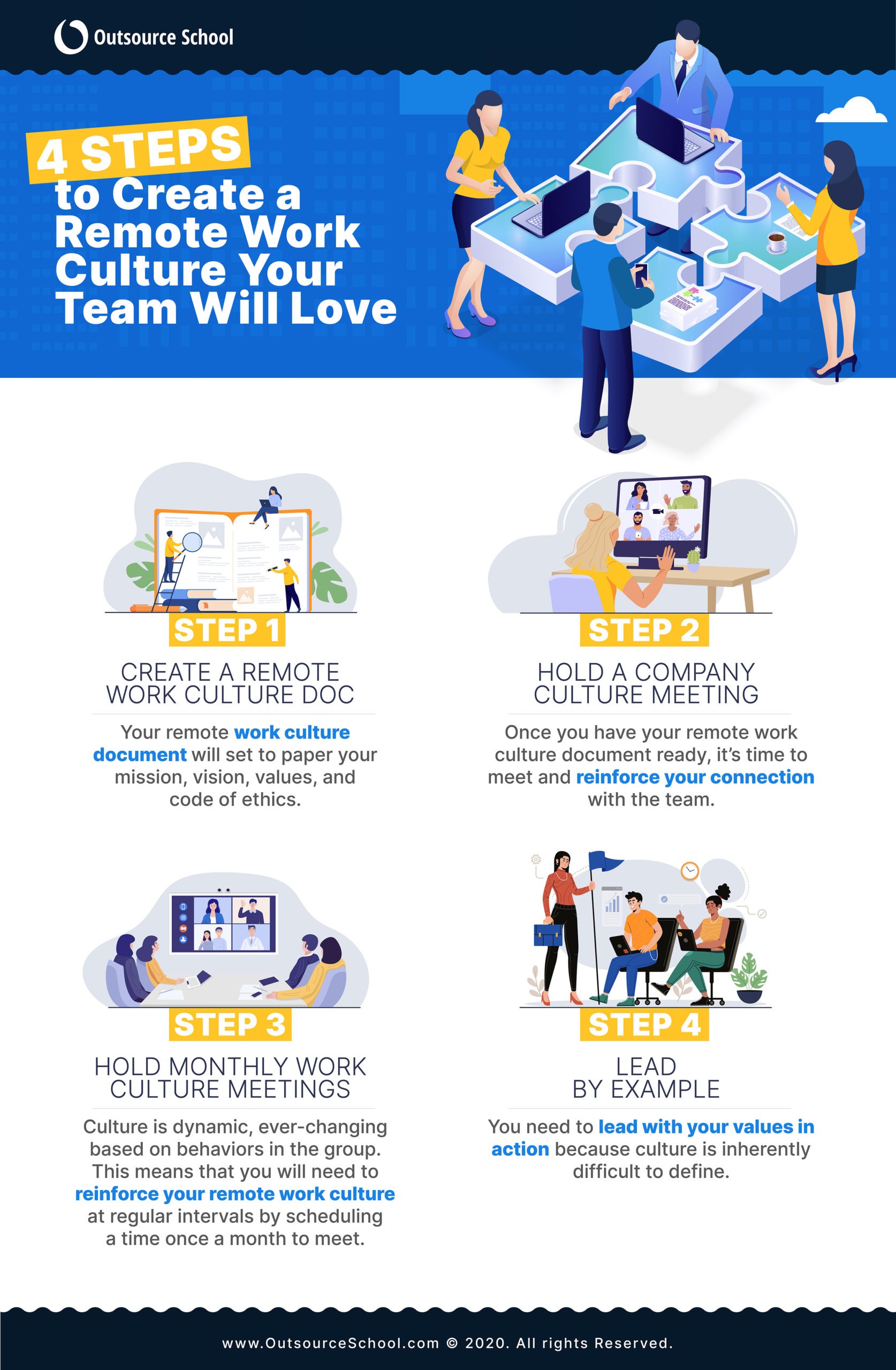Are you struggling to develop or adapt to a remote company culture? Establishing and nurturing a company culture can be difficult in and of itself. Often, when a business starts as fully remote or transitions to a remote workforce, it can be even more challenging. This is simply due to the nature of remote work, and how unfamiliar it is to a lot of business owners.
In this post, we’ll share four activities that you can engage in with your virtual hires to help you keep your remote company culture thriving.

(1) Weekly All Hands Meetings
At Outsource School, we start each week with an all hands meeting. This is not a meeting that is focused on remote company culture, but it supports the general atmosphere that we want to maintain. This is where we review goals and give company wide updates.
The meeting doesn’t have to be a long one. The key is holding a regular meeting that everyone is required to attend. It keeps everyone connected and builds stronger working relationships. We do this over chat because it’s just easier to have the chat record to go over as needed, rather than doing a call and then having to prepare a separate repository for shared files.
Connecting is Vital!
Meeting with just the key people in your company might seem like a wise use of your time. It may save you up to an hour a week, but it can have lasting negative effects. When you schedule a weekly all hands meeting, you are building rapport and accountability, which eventually builds loyalty and high productivity. These are priceless elements that every business should strive to develop. The 30 minutes or one hour you spend every week nurturing the team is a wise investment.
Make sure that your all hands meeting is scheduled for the same day and time every week. This shows stability and encourages everyone to be responsible with their time — including you. That’s a key quality that every business wants to encourage as part of their remote company culture. When you are the first one to make the effort to keep appointments, you show everyone else how important integrity is within your company. It’s a small gesture that speaks volumes. Of course, if something unavoidable comes up, you can reschedule the meeting — just don’t make it a habit.

Attendance
During your all hands meeting, always start by checking in to see that everyone is present. You want to show the team that when you say attendance is mandatory, you mean it. This establishes that your words mean something. The team will quickly learn that it’s not alright to disregard your instructions. That’s another vital aspect of any remote company culture. It’s too easy for someone to slip through the cracks when it isn’t likely that anyone will notice they are gone.
Make sure that if anyone did not show up for the meeting, you know the reason why. Instruct the team leader or manager to make sure that they know who won’t make it, the reason why, and to volunteer this information upfront as soon as you do the attendance check. This reinforces the respective responsibilities of informing immediate superiors of absences and passing on that information to you. It also includes monitoring and understanding valid reasons for absences and making sure that work is covered, which you need to be assured of as the business owner.
Temperature Check
Immediately following the attendance check, ask how everyone is doing. Encourage each team member to share, even if it’s just to say, “All good here.” Call them out by name if they don’t respond. This will encourage them to participate, especially where it counts the most. It also reinforces your care for them, showing them that you don’t care only about the work they produce but about them personally.
Again, two very important aspects of a remote company culture that will thrive. Following each response, make the effort to engage a little with the team members. This regular interaction is vital to developing stronger connections with each team member. As you set the example, team members will also engage with each other to strengthen their relationships.
Motivation
At Outsource School, we hold these weekly all hands meetings on Monday mornings. This is because it’s a great start to the week. After checking in, we dive into sharing work updates. You should start with your company wide updates. First, inspire the team with goals met and other wins from the past week. This keeps motivation high after the pleasant check-in banter as you move on to more serious topics. Then, share the goals that you are targeting for the current week. Tie them into the goals that you have set for the current quarter, too. This is so that you can keep everyone’s long-term focus set on the bigger picture.
The managers can jump in here to share what they will be working on to support those goals. Again, this sets the tone for everyone else in terms of expectations on goal setting and accountability. Ask the team if they have any questions about the goals. You want to make sure that the direction for the week is completely clear. Finally, pass the baton over to the rest of the team members. You should have a general format for them to follow when sharing updates, which you exemplify. This keeps everyone focused and keeps the information easy to receive and understand. Lists are great for updates on the past week’s accomplishments and targets for the current week.
At Outsource School, we also ask the team members to prepare questions, challenges, and solutions that they are facing within their roles. Stay focused as each one shares because you want to show appreciation for each contribution and motivate them to keep up the good work. You don’t want them getting the feeling that the meeting is just an empty requirement.
(2) Share Weekend Photos

One way that we love to use at Outsource School to build rapport with hires is sharing weekend photos. It covers the goal of getting to know team members outside of their work responsibilities, and it’s really fun, too. This personal sharing activity is a perfect fit for our Monday meeting schedule. Not everyone has weekends off, of course, but most do, and most will engage in weekend activities anyway because that’s when family members and friends are available for rest and relaxation.
At the start of each week, ask everyone on the team to share photos of what they did over the weekend. If you’re not doing your all hands meeting on Monday mornings, you can always schedule this activity separately in your all hands group chat. We have also found that sharing photos creates a deeper personal connection among team members than just sharing stories or getting away with a simple response. It also saves time because, as the saying goes, a picture is worth a thousand words.
Rapport is the Key!
Trust is of ultimate value when working with teams, and this rapport builder activity is golden. It’s a gentle way to encourage participation from new hires. You also get a chance to learn important things about them without being overtly intrusive (which does not yield positive results). It’s also a great way to stay up to date with what’s happening in the lives of long-term team members. Relationships need to be nurtured, so you need a regular activity like this to build and keep them. Relationship is also a prerequisite to trust, which you need to create a remote company culture that will thrive. Moreover, a vibrant remote company culture will work to build a team that functions effectively. You’ll see improvements in areas like communication, for example, as people grow comfortable with each other and develop mutual respect.
(3) Monthly Culture and Team Meetings

This is a meeting where you will focus specifically on your remote company culture. This is an important opportunity for you to talk about the culture, reinforce your values, and remind people of your vision as a company. Keeping the team excited about the future goes a long way towards maintaining a high level of motivation and genuine investment in the company — as opposed to being invested simply in a weekly paycheck.
Your company mission, vision and values may not change much over time. Culture, however, is a living thing, a dynamic construct that can change constantly. If you want to maintain your remote company culture within certain boundaries, you need to work to preserve it. Behaviors in the group can influence your remote company culture, so that’s one big area that you need to keep an eye on.
During your monthly culture meeting, make sure that you always have a culture check as a main point on the agenda. The main goal of this meeting is to regularly reinforce your remote work culture and clean out anything that threatens it. Some changes can be good, and you might want to incorporate them, but you need to be vigilant and critical so that you can ensure that nothing gets in that can have long-lasting negative effects.
Getting Ready for Meetings
Schedule a time once a month to hold a remote company culture meeting. Make it an event, not just another meeting. Yes, everyone should be expected to participate, but it’s more than just a requirement.
At Outsource School, we create anticipation for each culture meeting by expressing genuine interest and excitement for the activity. We always make an effort to demonstrate that our culture is value-driven, and our team leaders and managers are with us on this. We also put a focus on hiring people who are all on the same page with us from the get-go. Everyone agrees and exemplifies the core values that make up our remote company culture and knows how important it is to uphold it. So, everyone sees the meeting as a positive exercise.
Expectations
Prepare for these company culture meetings by outlining specific points that you want to review. This means that you need to have a list of culture points from the previous month. Start by celebrating people who have been awesome culture ambassadors for the company. This encourages them to keep reinforcing the remote company culture in their own conduct, thereby also encouraging others to do the same. Then go over any trouble spots that you have observed over the past month in the day-to-day of your business.
Management
Appoint the team leader and / or individual department managers to gather and compile the information so you are not spending too much time trying to monitor everyone. Then make sure that you understand each incident. You will need to know the key details of what’s going on so that you can identify which issues stem from misunderstandings about the culture, for example, or disagreement with it, versus blatant non-compliance rooted in arrogance or outright rebellion. Most issues will not be too bad. In any case, you will want to get wind of any potential ones early on so you can stop them from growing into major problems with huge negative effects.
Holding Meetings
Begin the monthly culture meeting as you would your all hands meeting. Reinforce your connection with the team through check-ins, then present the agenda. After this, introduce any new hires to the rest of the team and give them a few minutes to welcome them warmly.
Before joining the monthly culture meeting, new hires need to be taken through your remote company culture documents step by step. This should ideally happen during their onboarding. This is so that they are familiar with the culture before they come to the meeting, and you have already confirmed that they have no questions or objections. This way, they can focus on the specific concerns at hand. (Note that if any new hire is not in complete agreement with the culture, it will be risky to keep them on.)
Finally, call the meeting to order so that everyone shifts into gear, ready to tackle the content. After you have gone over the points, don’t forget to ask if anyone has any questions. Patiently answer all concerns. Remote company culture is a delicate organism, so you don’t want to threaten it by making anyone feel like it’s just another set of rules that they need to follow. Culture is a choice, and you want to encourage everyone to love your remote work culture, not fear it.
(4) Monthly Happy Hour Video Calls

This meeting is another way to support the culture and relationships, but with a focus on pure fun. It’s a time to play games and do other enjoyable activities together, have a drink, and get to know one another personally without any other agenda. This allows everyone to get together for the sole purpose of chilling and bonding. This is the one meeting that we prefer to host on a video calling app like Zoom. We don’t need any notes, we just need to enjoy each other’s company.
You can start holding a monthly happy hour immediately. The only preparation needed is deciding what games to play, and making sure that you can do them online without too much trouble. Note that the best team building activities are the ones designed to strengthen communication and cooperation, encourage efficiency, and support for team members. At Outsource School, we take turns hosting so that everyone gets a chance to pick the activity and be responsible for the event.
We have found that a monthly happy hour is valuable team building time because it’s not connected to work. Having this break from work and spending the time together solidifies relationships and builds trust and loyalty in a different way than any other work-related activity. We all need to give some attention to the purely personal angle so we don’t fall into the trap of seeing everyone in terms of their value as workers.
Final Thoughts
Help your teams to develop the habit of focusing on a common purpose through these activities. You want to build a system where everyone can work within an edifying remote company culture framework. This enables team members to take pleasure in exercising their abilities. It also promotes accountability with positive instead of negative reinforcement. Make your remote company culture thrive by introducing these activities as soon as possible.
Would you like to know how to be certain who your next hire should be? Or maybe you are having a hard time deciding what parts of your business can be outsourced with virtual assistants, right now. We can help you answer these questions, and help you to discover what new systems you should add to scale your business faster. Set up a free hiring consultation with us at Outsource School today – simply book here!








